Ditch pricey pre-made options and learn how to make lactose free yogurt four different ways! Learn simple steps for choosing the right milk, selecting starter cultures, options for incubating, as well as customizing with fruits, nuts, and flavors you love.
Explore our guide for easy-to-follow fermentation instructions and tips, for making your own delicious, probiotic, lactose-free version today.
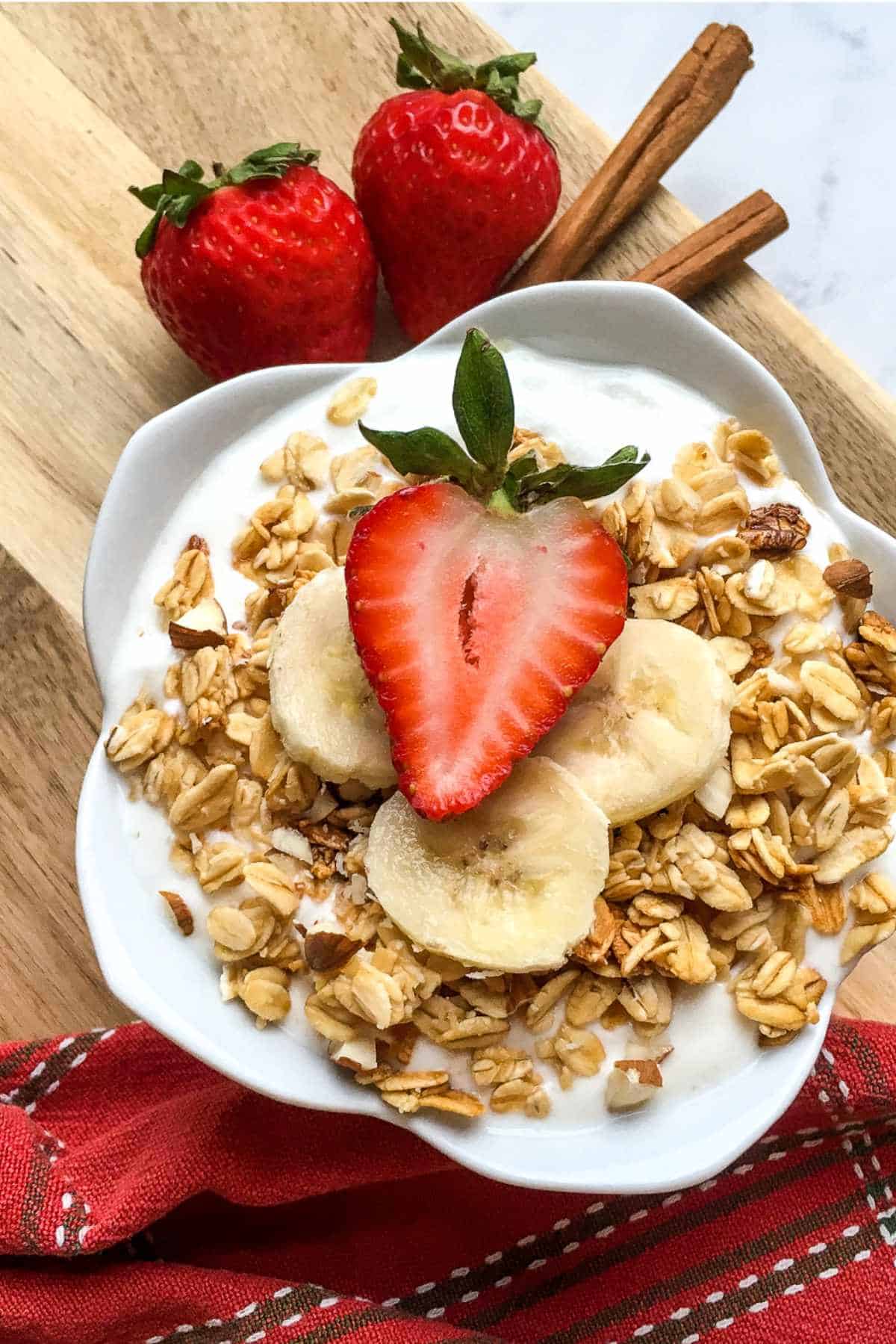
Why Does Lactose-Free Matter?
Lactose free yogurt is made from lactose free milk is made by adding the lactase enzyme to regular milk, breaking down lactose into simple sugars that are easier to digest, and then processing it into yogurt.
Finding yogurt that is made using lactose free milk is hard. Finding GOOD lactose free yogurt is even harder.
There are several non dairy substitutes, but none really come close to actual dairy milk versions.
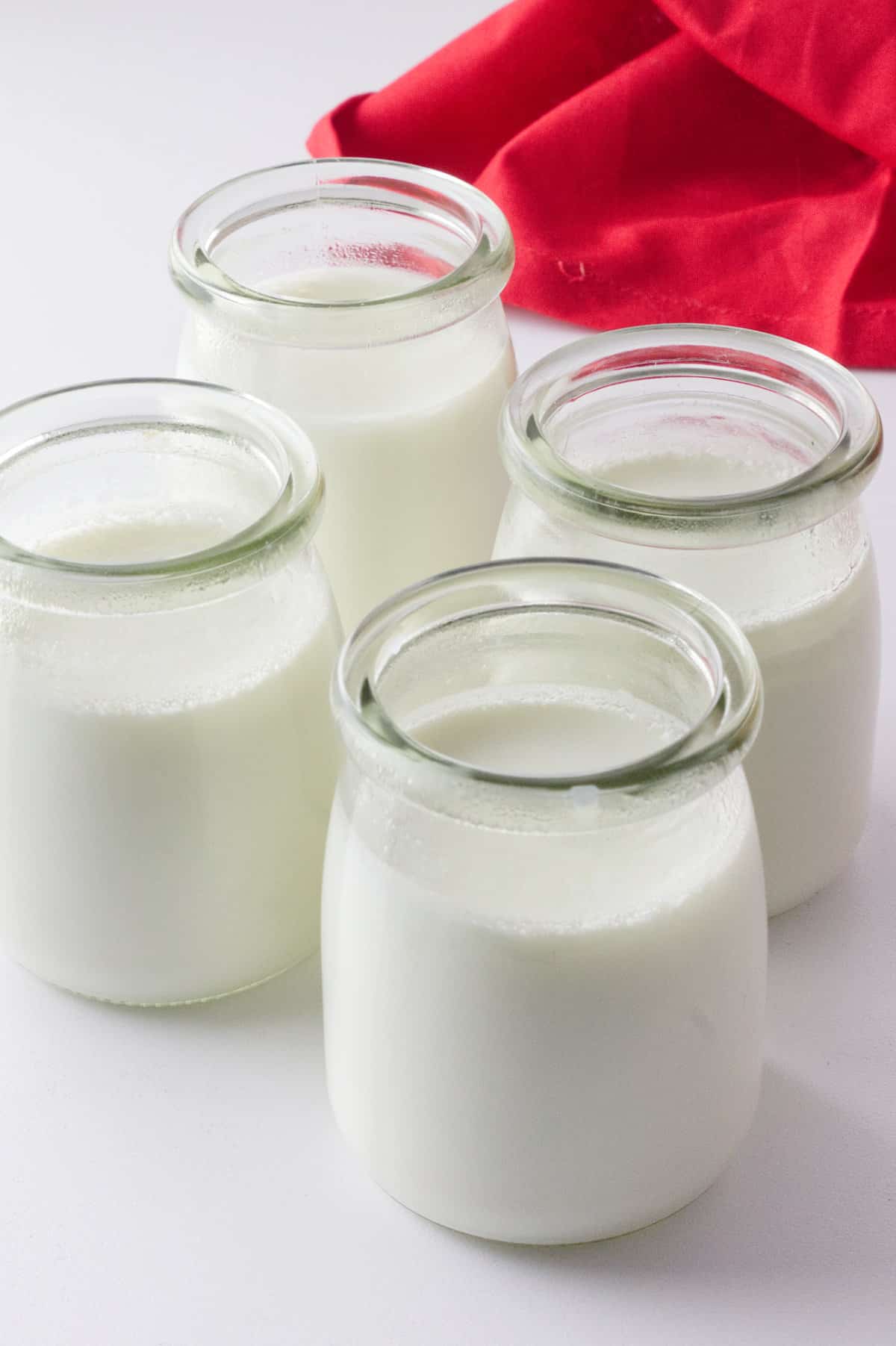
Why You'll Love Making Lactose-Free Yogurt
There's nothing quite like eating yogurt that you made yourself. You can use lit in all the same ways as regular yogurt, but it's also a great option for people with lactose intolerance.
Good option for people with lactose intolerance. Lactose-free yogurt is made without lactose, so it's easy to digest for people with lactose intolerance. Lactose intolerance is a condition in which people have difficulty digesting lactose, the natural sugar found in milk.
Great source of probiotics. Probiotics are live bacteria that are beneficial for our gut. It's is a good source of probiotics.
Economical. Making your own is a great way to save money on groceries. Lactose-free yogurt can be expensive in stores, but it's much cheaper to make at home.
Ingredients You'll Need
With just a few ingredients you can have lactose free yogurt on hand at a fraction of the store bought cost. It will be so much better in quality also!
This tutorial will show you how to transform store bought lactose-free milk into creamy delicious yogurt for those who are lactose intoleratnt.
You can use an Instant Pot, Crock Pot (slow cooker), or the Proof setting on a conventional oven. The process is simple and the results are delicious and a fraction of the cost of store bought.
If you have an electric yogurt-maker, than you can simply follow the directions on the appliance for the incubation and culturing times.
- Lactose Free milk - (any brand, pasteurized is preferred, but any brand of lactose free milk will work)
- Dry yogurt culture starter - (I prefer the Cultures for Health Bulgarian) OR some fresh, plain, live cultured yogurt.
Full ingredient amounts and preparation instructions are in the printable recipe card at the bottom of this post.

4 Ways For Making Lactose-Free Yogurt
This is a pretty guide using various methods to incubate, or ferment yogurt. And, contrary to popular belief, you CAN make yogurt with ultra-pasteurized, lactose free milk.
You'll need to plan ahead on the type of starter, and the method of incubating the prepared milk so that it has a steady, warm heat to ferment in. This is what thickens the milk.
We will cover using the conventional oven, Instant Pot, and Crockpot (slow cooker), and electric yogurt maker methods.
First, Choose A Yogurt Starter
You'll need live cultures to make homemade yogurt of any kind. You can use a 3 tablespoons of the unflavored plain (Greek or regular plain yogurt), or if you don't have any, you can use a dehydrated starter.
After making your first batch, always save 3 tablespoons of your new lactose free yogurt for your next batch, though it's easy to forget (ask me how I know). Starter will keep in the refrigerator for up to 1 month.
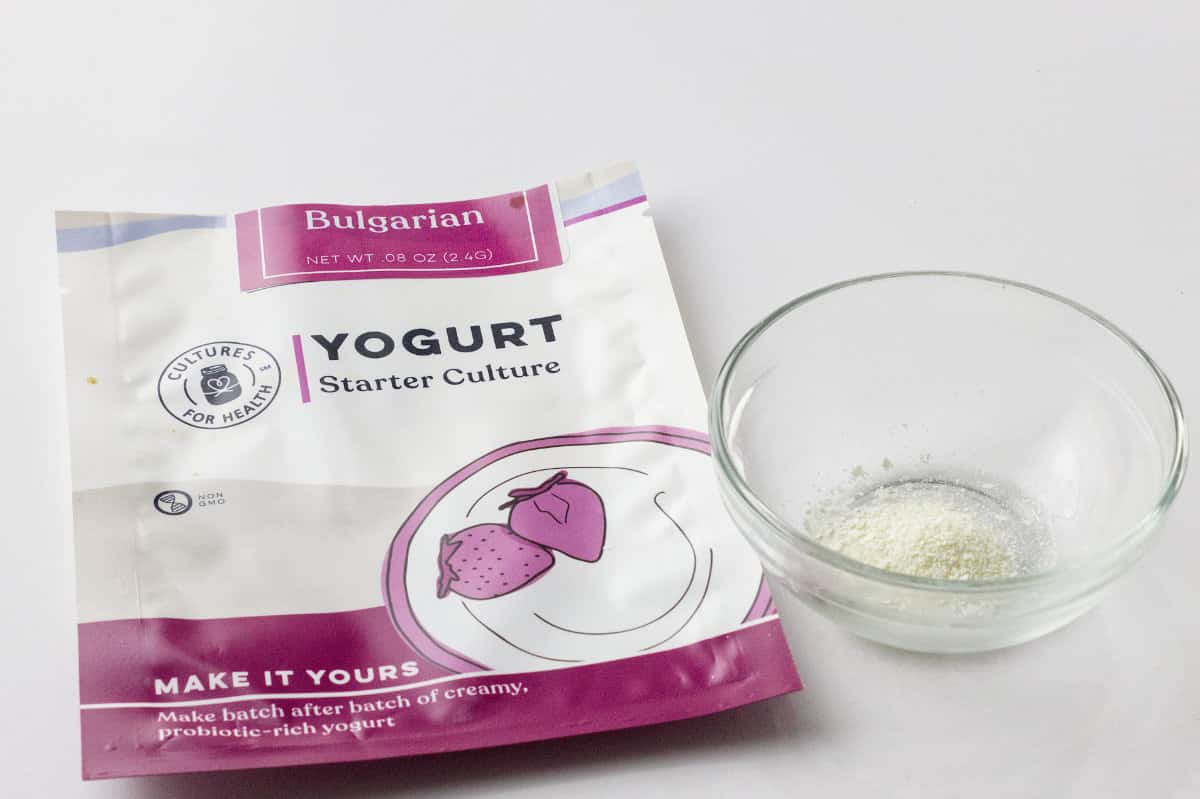
My favorite starter (when I forget to set some yogurt aside to start the next batch) is the Cultures for Health Bulgarian or Greek yogurt starters.
Prepare The Lactose Free Milk for Culturing
- Start with any brand of lactose free milk. If you get the Ultra Pasteurized, you only need to warm it to 110 degrees F. If it is unpasteurized, heat to the typical 160 degrees F and then cool it to 110 degrees F.
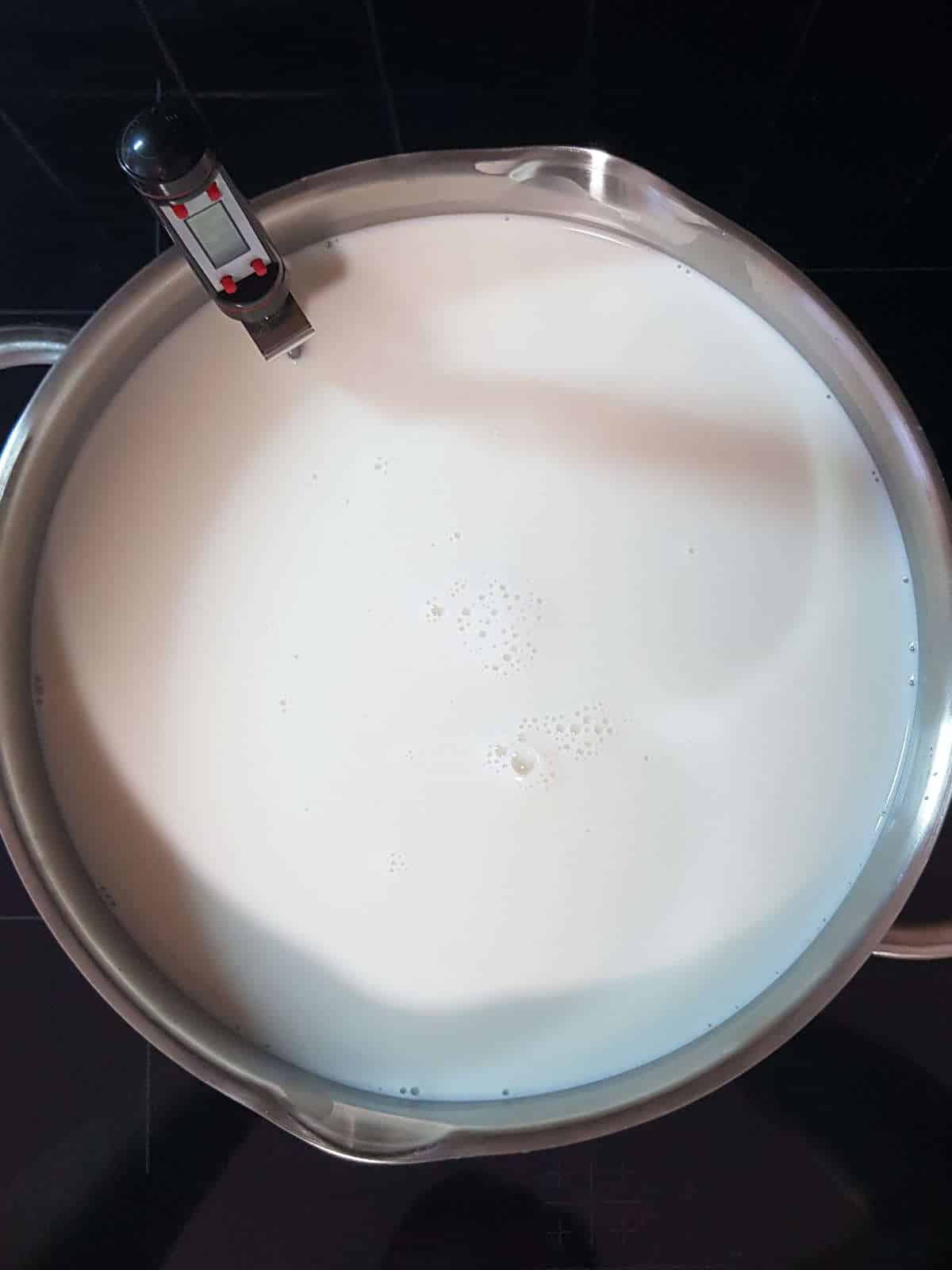
- Heating in a large pot and monitoring the temperature with an instant read thermometer.
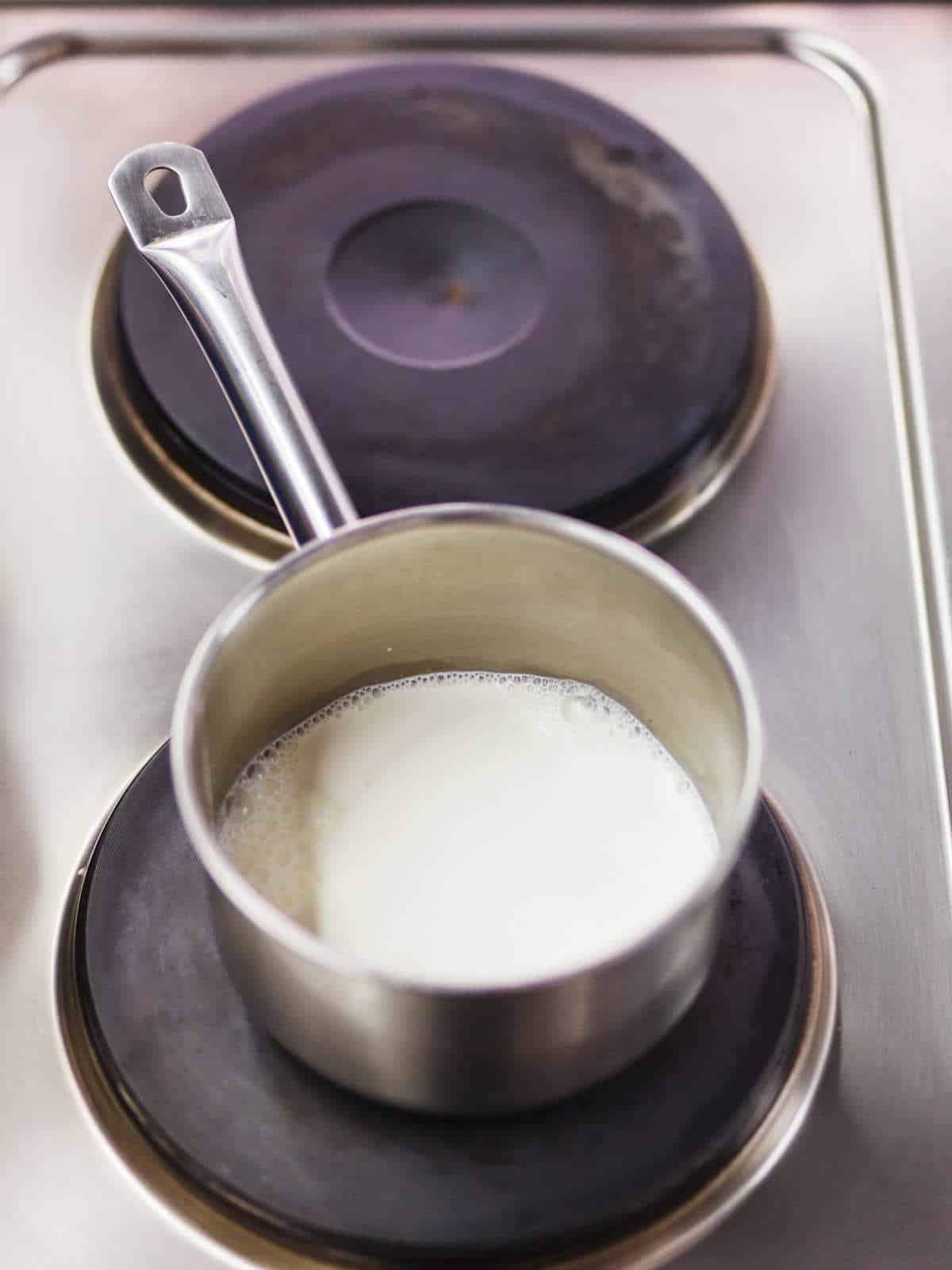
- Milk in a pot heating to 110 degrees F for Ultra Pasteurized milk. Unpasteurized milk should heat to 160 degree F.
Prepare the Starter
- In a small bowl put either the initial starter, or a few table spoons of a live cultured, unflavored yogurt. Blend in a little bit of the warm milk. Make sure it is smooth.
- Then transfer it back to the pot with the main milk. Stir well and pour into either the individual jars or large culturing bowl.
- Now it's time to decide which method of incubation, or maintaining a low stead warmth you will use to let the cultures do their magic.
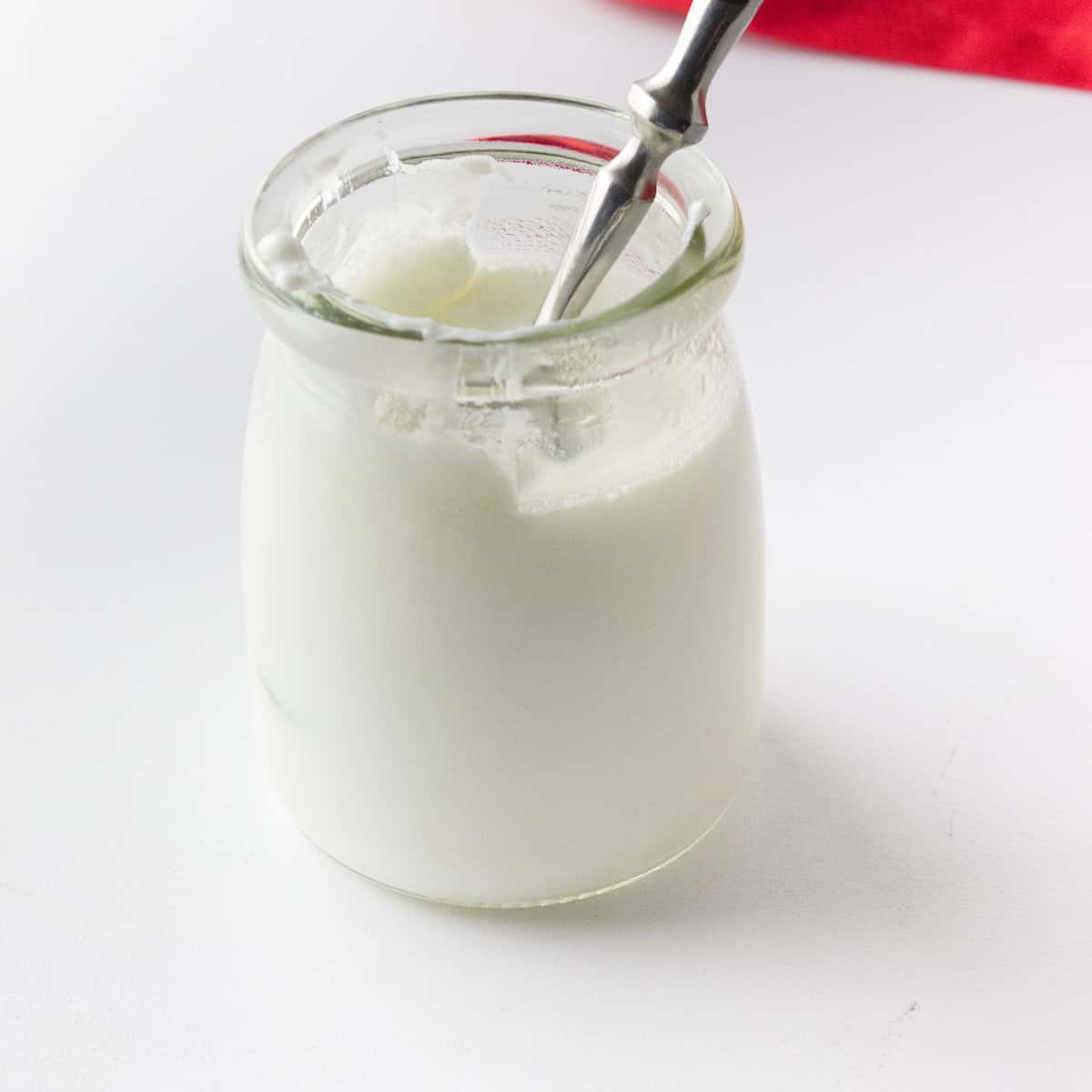
Pour Into Containers and Choose Culturing Method
Below are four different incubating methods for culturing your milk and incubating.
Read below to decide what method of culturing will work best for you. There are instructions for using the following methods:
- The 'Proof' setting on a conventional oven, or 100 degrees F. Perfect for low temperature baking large trays of individual size serving jars.
- Instant Pot method, more suited to a batch of four to five 6 oz jars, or a large container.
- Crockpot method, suited for about six to eight 6 oz jars or a large pot.
- Electric Yogurt maker, which is a self contained plug in appliance that makes six to eight 6 oz jars and then turns off.
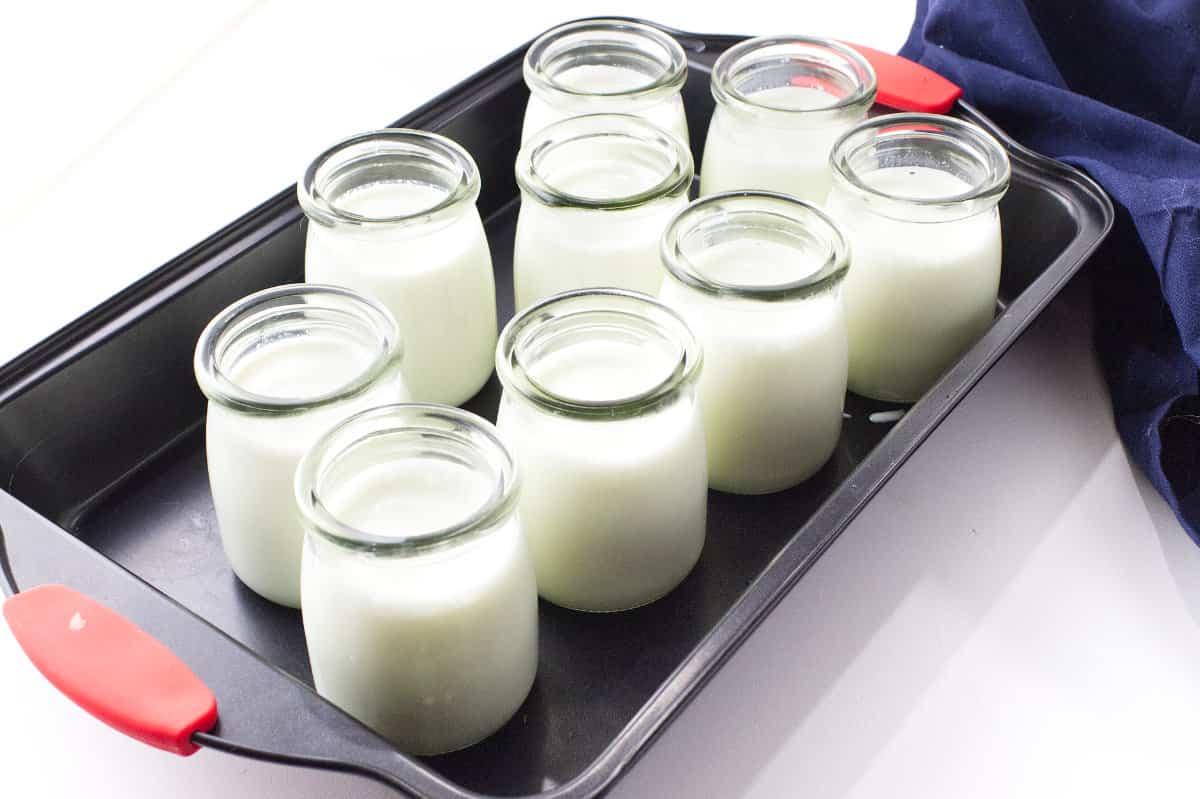
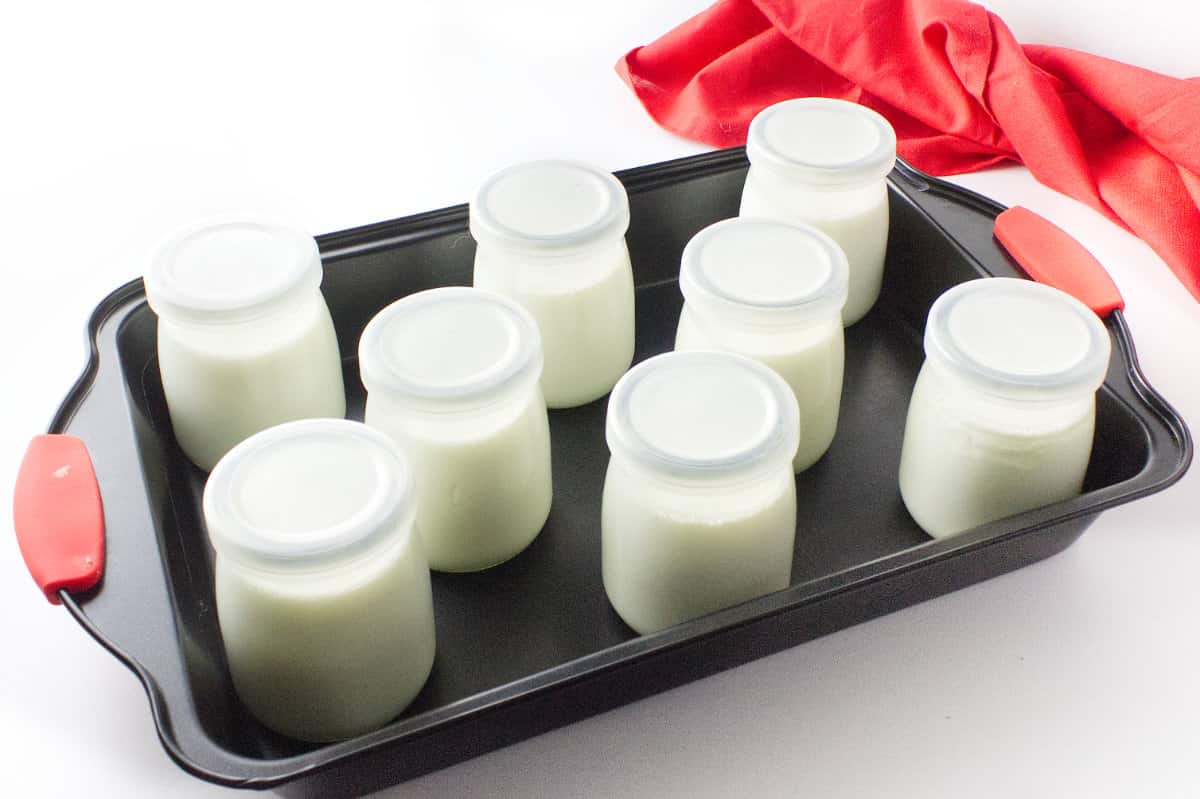
Substitutions and Variations
- Try adding either fruit jam to the bottom of the jars before setting to culture, or add a few pieces of fresh fruit. The fresh fruit will float, but it will not stop the culturing process. Just don't stir in anything with sugar, as that will stop or slow the culturing.
- You are in control of how thick, the ingredients, and even the level of sugar from add in's.
Tips for Success
- Buy any brand Lactose Free milk, I've tested this with expensive Lactose Free milk brands, and store generic. No differences at all.
- Make sure you use plain, unsweetened, live culture yogurt as your starter
- The amount of time you incubate filled jars will determine the final flavor and firmness. Example: 8 hours of incubation will result in a milder flavor, while 12 hours will be more tart. 8 hours of incubation is a less firm yogurt, where 12 hours incubation creates a much more solid and thick.
- Always use a rack or some sort of 'lift' from the heating element when using an Instant Pot or Slow Cooker.
- Don't add any water to the Instant Pot or Slow Cooker, as you don't want to create any steam or pressure.
- If none of the methods listed here are available to you, simply buy a yogurt maker, as it will make anywhere from 4 to 8 cups.
Conventional Oven 'Proof' Method
If you have a conventional oven with a 'Proof' setting, than you are SO lucky!
The 'proof' setting is about 100 - 110 degrees F, and it is used for letting dough rise. But it is also perfect for fermenting milk into yogurt!
- Set the filled jars on a baking sheet in the oven and set the oven temperature to the 'Proof' setting.
- Let them sit there overnight, or about 10 to 12 hours max.
- Remove from the oven and voila! Perfect lactose free yogurt!
- Cool for at least 4 hours, and then serve!
PRO TIP: The 'warm' setting on the oven is going to be too hot if it is over 120 degrees F.

Instant Pot Method
- You'll be able to make a full tub using an Instant Pot, or up to 5 individual jars. Use the rack so the jars don't touch the bottom of the Instant Pot.
- Most Instant Pots have a 'Yogurt' program, so all you have to do is close the lid on the rack of jars or full bowl of milk mixture and set the program button.
- If your Instant Pot doesn't have a yogurt program button, you can also use the 'Warm' setting, but leave the lid cracked as it is warmer than the yogurt setting. Let sit for 8 to 12 hours.
- Cool for at least 4 hours in the refrigerator, and then serve!

Crock Pot Method
You can also use your Crockpot or any slow cooker also.
- Put a rack inside the crockpot. Set the individual covered jars, or a single plastic wrap covered bowl on the rack.
- Put the slow cooker lid on slightly askew, and put the setting on warm. Let it sit for 8 to 12 hours.
- Cool for at least 4 hours, and then serve!
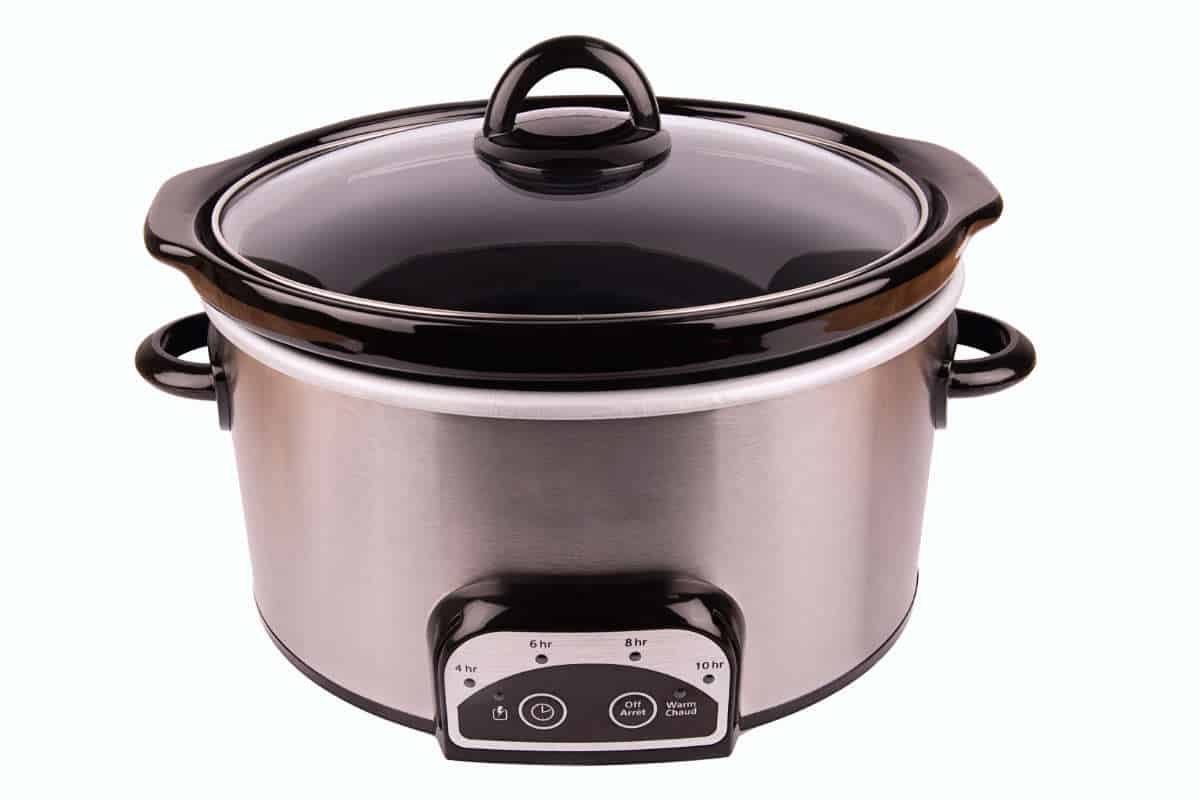
Electric Yogurt Makers Method
Electric yogurt makers vary from one manufacturer to an other. The basics are pretty standard though. They typically comprise of a tray that holds 4 to 8 small jars, each about 6 to 8 oz.
- You fill each jar with the prepared, cultured milk, cover with a see through lid, and turn the electric yogurt maker on.
- It runs at a very low (110 degrees F) for up to 12 hours and then turns off.
- When it turns off, put the jars in the refrigerator and let the jars of yogurt chill and firm up.
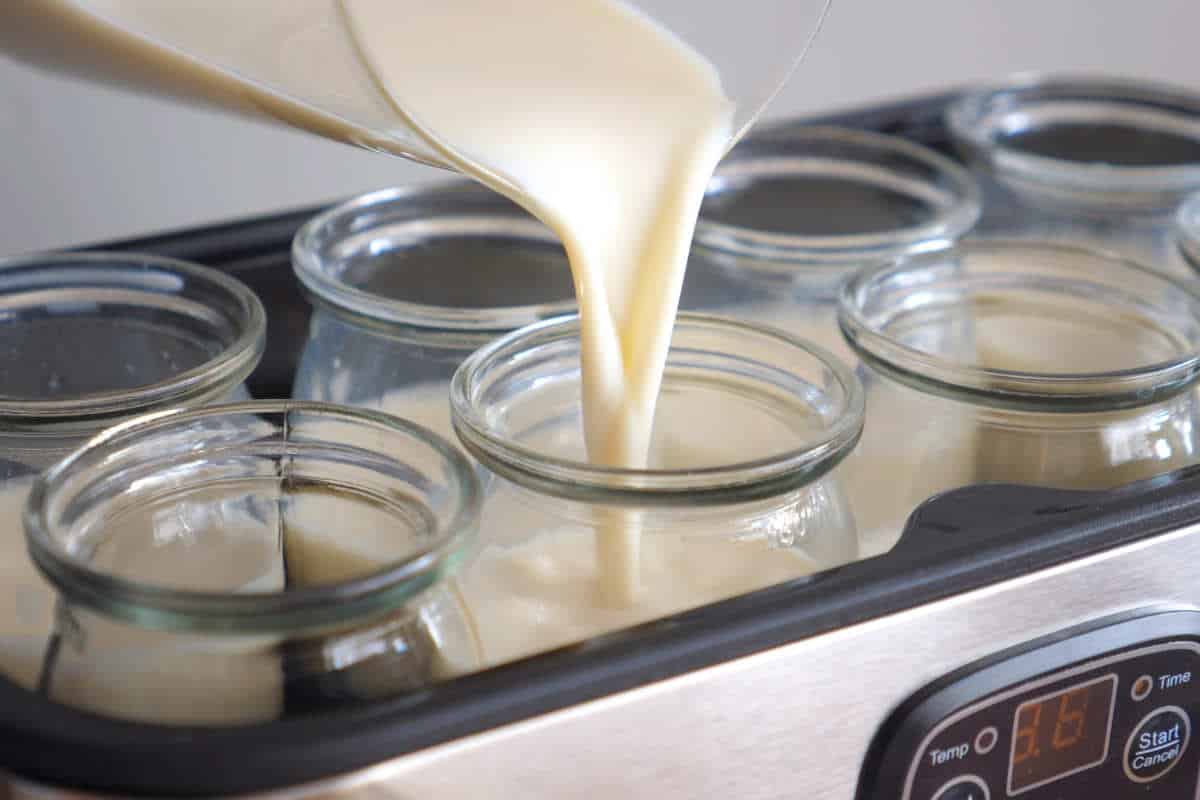
Serving Suggestions
Homemade lactose-free yogurt offers a delicious, cost-effective, and rewarding way to enjoy the benefits of yogurt without the limitations and discomforts of lactose intolerance.
Serve as a breakfast food, top with fruit and granola for an easy dessert.
You can also use as a substitution in recipes calling for sour cream, cream, or half & half in recipes like our Cucumber Mint Biryani Raita or Chicken Tikka Masala.
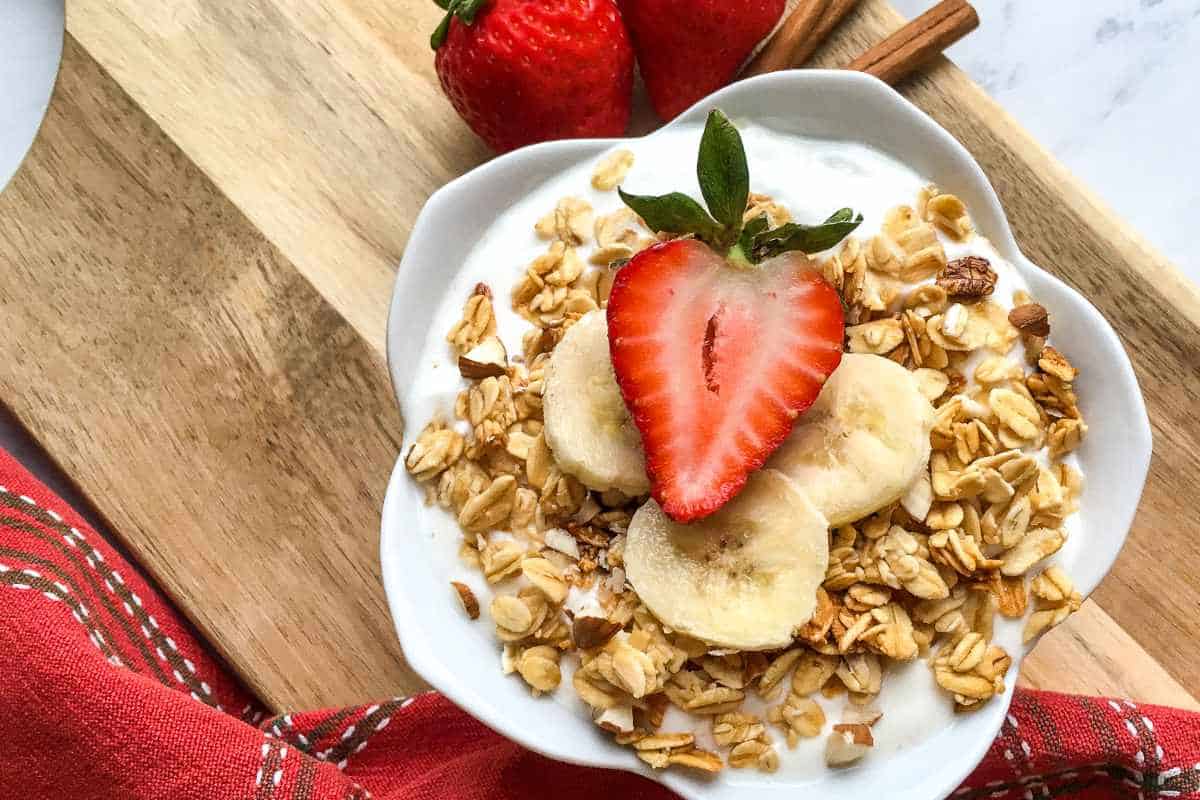
Storage Options
- Allow the the jars to cool, then store in the refrigerator for up to 1 week.
- Save ¼ cup of the yogurt in the freezer for making your next batch of lactose-free yogurt.
Related Recipes
- Peaches and Cream Smoothie
- Birthday Cake Funfetti Ice Cream
- Chocolate Marshmallow Ice Cream
- Acai Berry Gelato (Acai Berry Ice Cream)
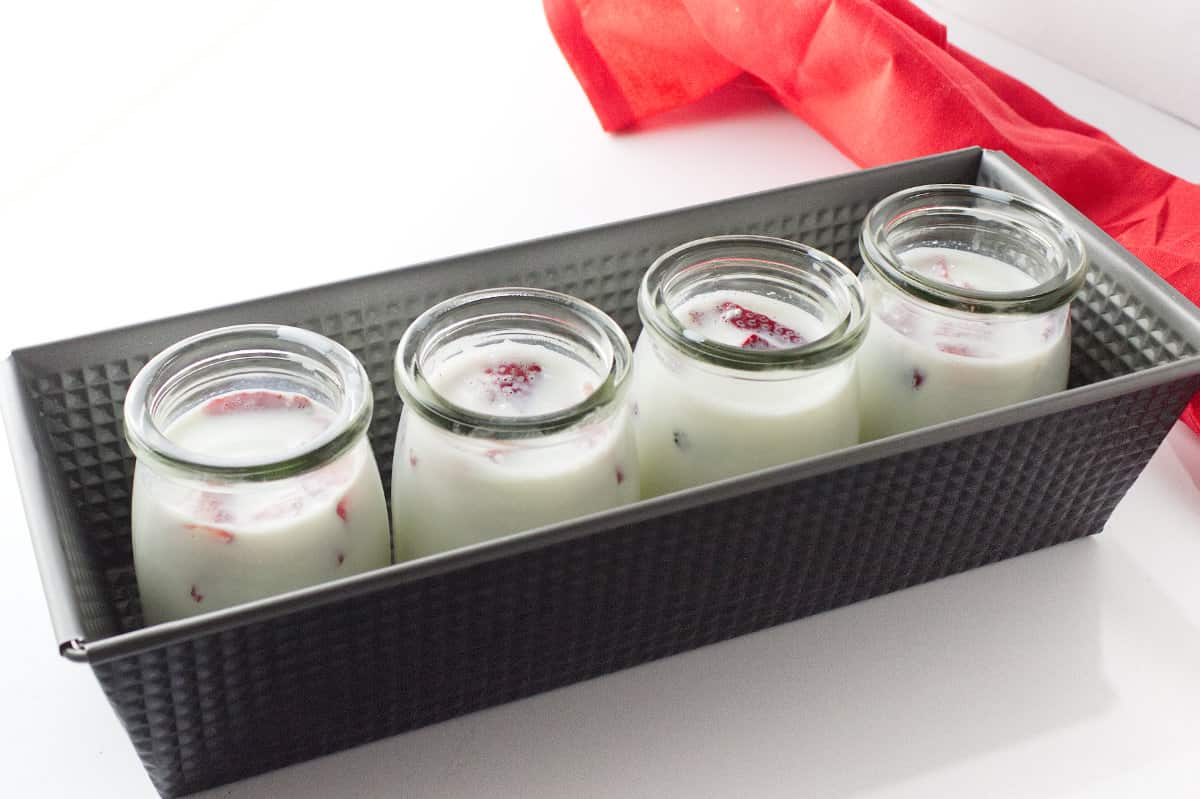
Equipment
Any of these three tools will allow you to control a warm environment for your cultured inoculated milk.
As an Amazon Associate I earn from qualifying purchases.
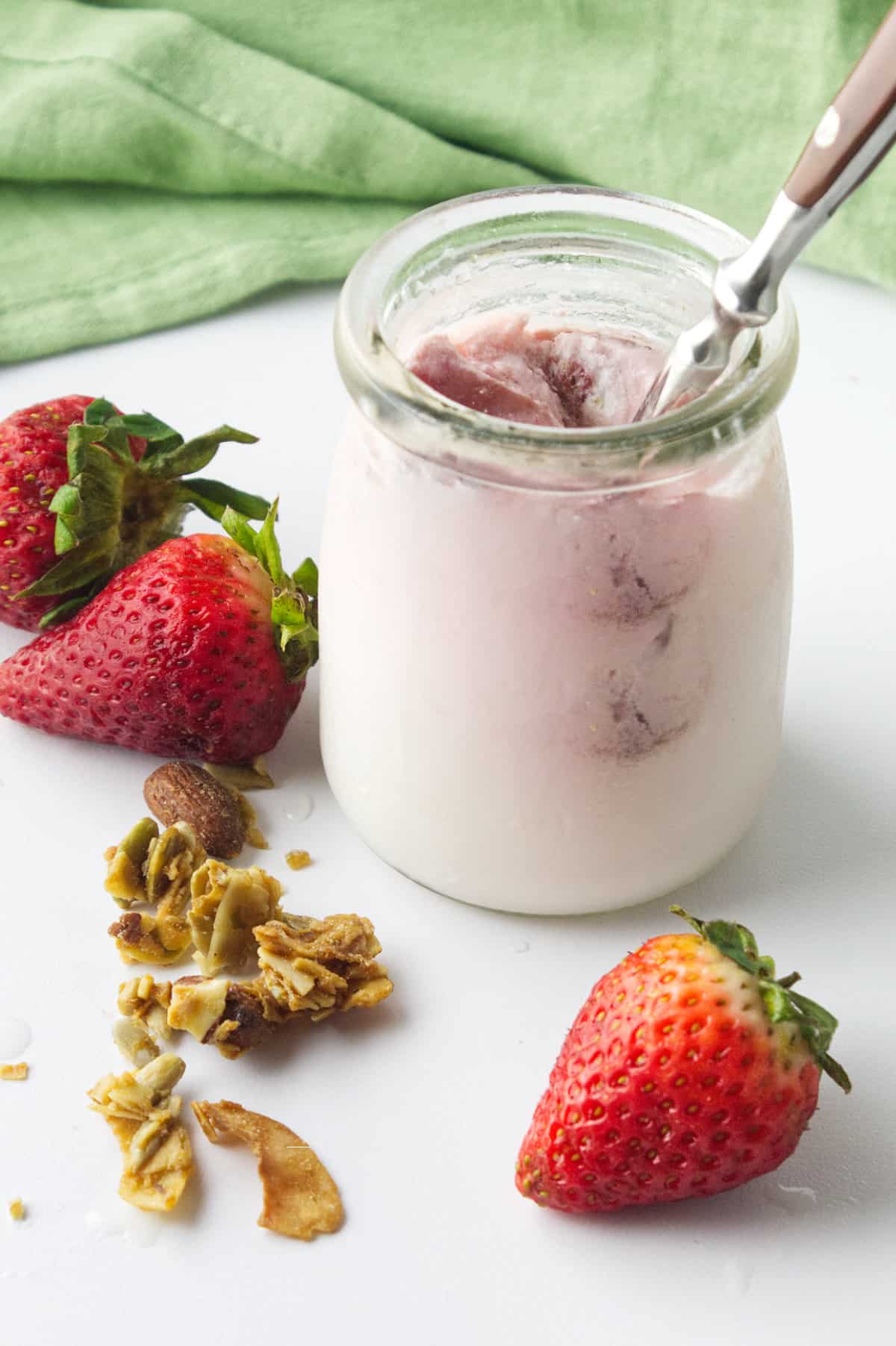
Other Recipes Using Yogurt
- Easy Cucumber Biryani Raita
- Instant Pot Chicken Tikka Masala
- Peaches and Cream Smoothie
- Easy Raspberry Smoothie
- Indian Cucumber Salad
Frequently Asked Questions
Yes, the texture may be less thick, but it will absolutely ferment just as nicely as full fat milk.
Yes, measure some of your last batch of lactose free yogurt into ¼ cup containers and freeze it up to 6 months.
Yes, you can spread some out on a food dehydrator on the cooler setting. Spread it thin so it dries quickly. Gather up the dry shavings and grind, save in an airtight container for up to 8 weeks.
You'll need to start your first batch with at least 3 tablespoons of live, unflavored, unsweetened yogurt like plain Fage. 3 tablespoons to ¼ cup should be saved with every new batch of yogurt to use for your next batch.
Lactose-free is still a dairy (cow, goat, and sheep's milk) product. Dairy free means it's specially cultured soy, coconut, almond, or other plant based 'milk' product.
More Delish Ideas
- Classic Panettone Bread
- Easy Nutella Crescent Rolls
- Easy Raspberry Smoothie
- Banana Bread with Self Rising Flour
Make Lactose Free Yogurt (4 Different Ways)
Equipment
- 8 8 oz rounded Ball Canning Jars (or other small jars)
- 1 Crockpot
Ingredients
- 64 oz whole lactose free milk (1 half gallon)
- 1 envelope yogurt cultures (or 3 tablespoons to ¼ cup plain yogurt with live cultures)
Instructions
- Wash the jars or a bowl (that fits either your Instant Pot or Crockpot) and set them aside to dry. Open the envelope of yogurt cultures and empty into a small bowl. Rehydrate by adding a few tablespoons of slightly warm (tepid) water. Stir and set aside. If using yogurt for your starter, use 3 tablespoons and put in a small bowl. Set aside for after your milk is heated and cooled.1 envelope yogurt cultures
- In a stainless steel pot, bring the milk to 110 degrees if the milk carton says "Ultra Pasteurized". If the carton does not say this, bring the temperature to 160 degrees F. Stir frequently to disperse heat and not scald. As soon as your milk reaches it's temperature, remove from heat to cool. Continue to stir so that the milk cools faster.64 oz whole lactose free milk (1 half gallon)
- Once the milk cools down to 110 degrees F, remove about 3 tablespoons of the milk and add to the small bowl of re-hydrated yogurt cultures or the yogurt you used for starter. Stir well, and transfer to the pot of cooled milk. Use the whisk to blend it in well.
- Ladle or pour the cooled, yogurt culture inoculated milk into the prepared jars or the bowl.
Instant Pot Method
- Place a rack in the Instant Pot. Because only 5 to 6 jars will fit, use a bowl that fits inside your Instant Pot to pour the milk into. Place the bowl in the Instant Pot. Secure the lid. Use the 'Yogurt' program to culture your yogurt. You can also use the 'Warm' setting, but you may have to turn it back on if it shuts off automatically, or program in 8 hours.
Crockpot Method
- For Crockpot: Place a rack in the Crockpot. Put lids on the jars loosely and place one layer of jars in the Crockpot. Or pour into a bowl, cover with plastic wrap, and incubate the bowl of milk in the Crockpot. Secure the lid on the Crockpot loosely so it does not get too warm. Place the setting on 'Warm' and leave for 8 to 12 hours.
Oven 'Proof' Method
- For Ovens: If you have a newer oven, it may have a 'Proof' setting. Place lids on the yogurt. Place the jars in a 9x13 type of baking pan. Set in the middle of the oven. Set your oven to 'Proof' and leave for 10 to 12 hours.
Electric Yogurt Maker Method
- Electric Yogurt Maker:If you don't want to use an Instant Pot, Crockpot, and don't have an oven with 'Proof' settings, an electric yogurt maker will give you perfect results. Pour the milk in the jars and follow the appliance directions.
- After the 8 to 12 hour incubation time, remove the yogurt from the appliance you used to culture the yogurt. Set in the refrigerator for 4 hours before serving.
- Be sure to save ¼ cup of the new yogurt for your next batch!
Notes
- The Instant Pot & Crockpot can only hold about 5 to 7 small jars. You can either make a smaller batch of yogurt, or pour the milk into one larger bowl to incubate in the Instant Pot.
- Always use a rack in the Instant Pot or Crockpot to lift the jars or bowl up off the bottom of the heat element.
- No water is needed in the Instant Pot or the Crockpot methods. Only a warm environment is required, not steam or humidity.
- Be sure to save 3 tablespoons to ¼ cup of the new yogurt for your next batch!
- Settings on Instant Pots, Slow Cookers, and Ovens all vary.
- Make sure that if you use yogurt for your starter instead of a dehydrated starter, that it is unsweetened, live culture yogurt.

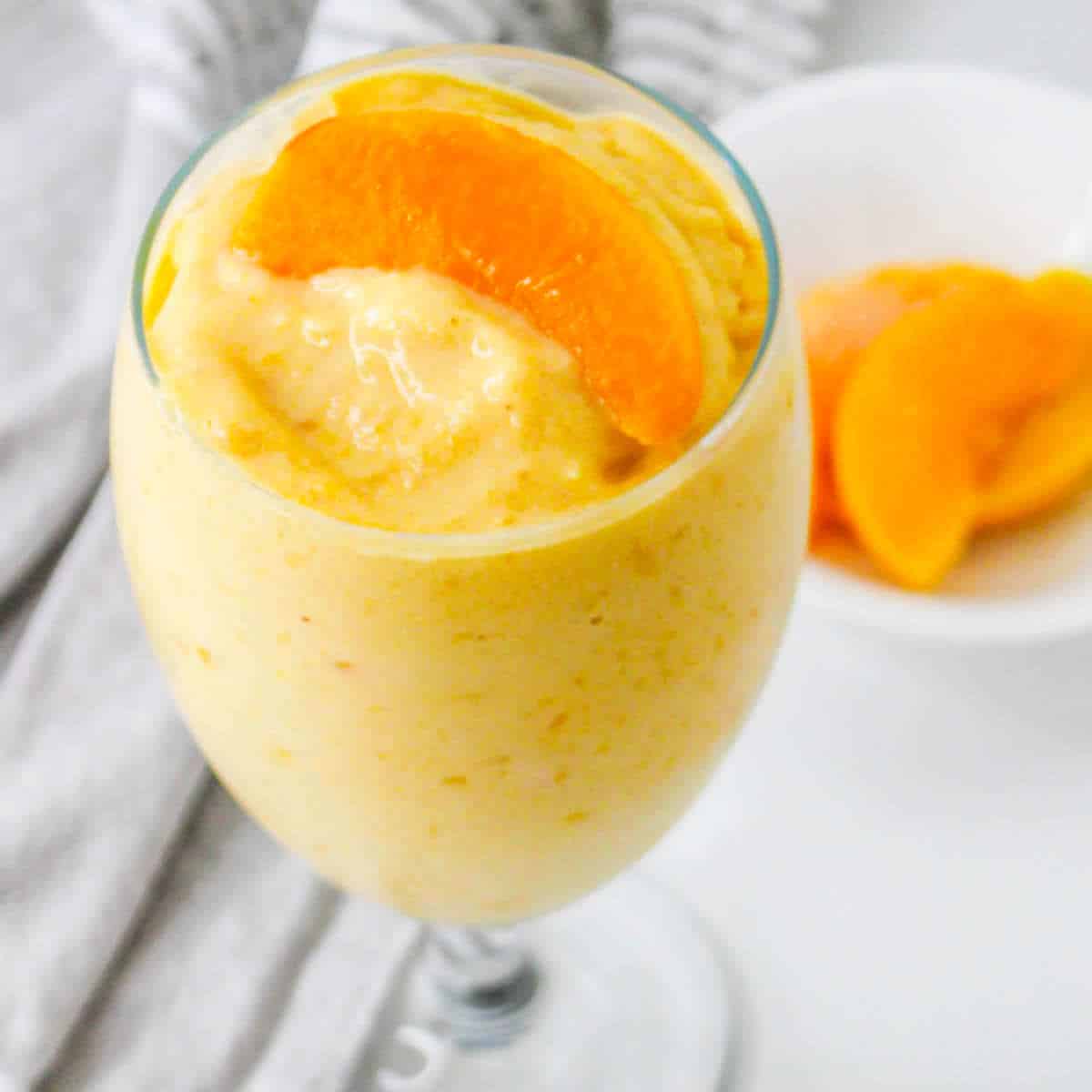

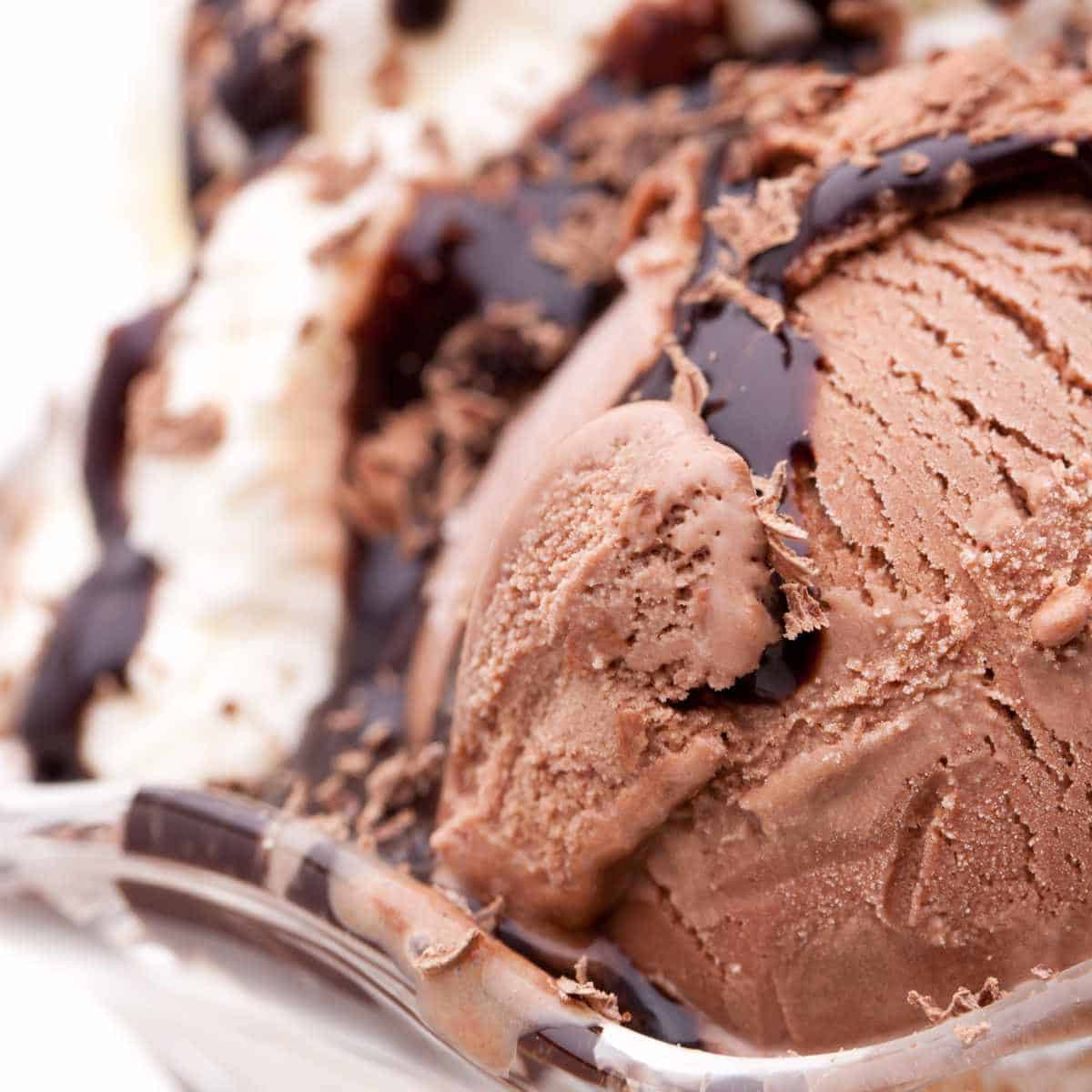

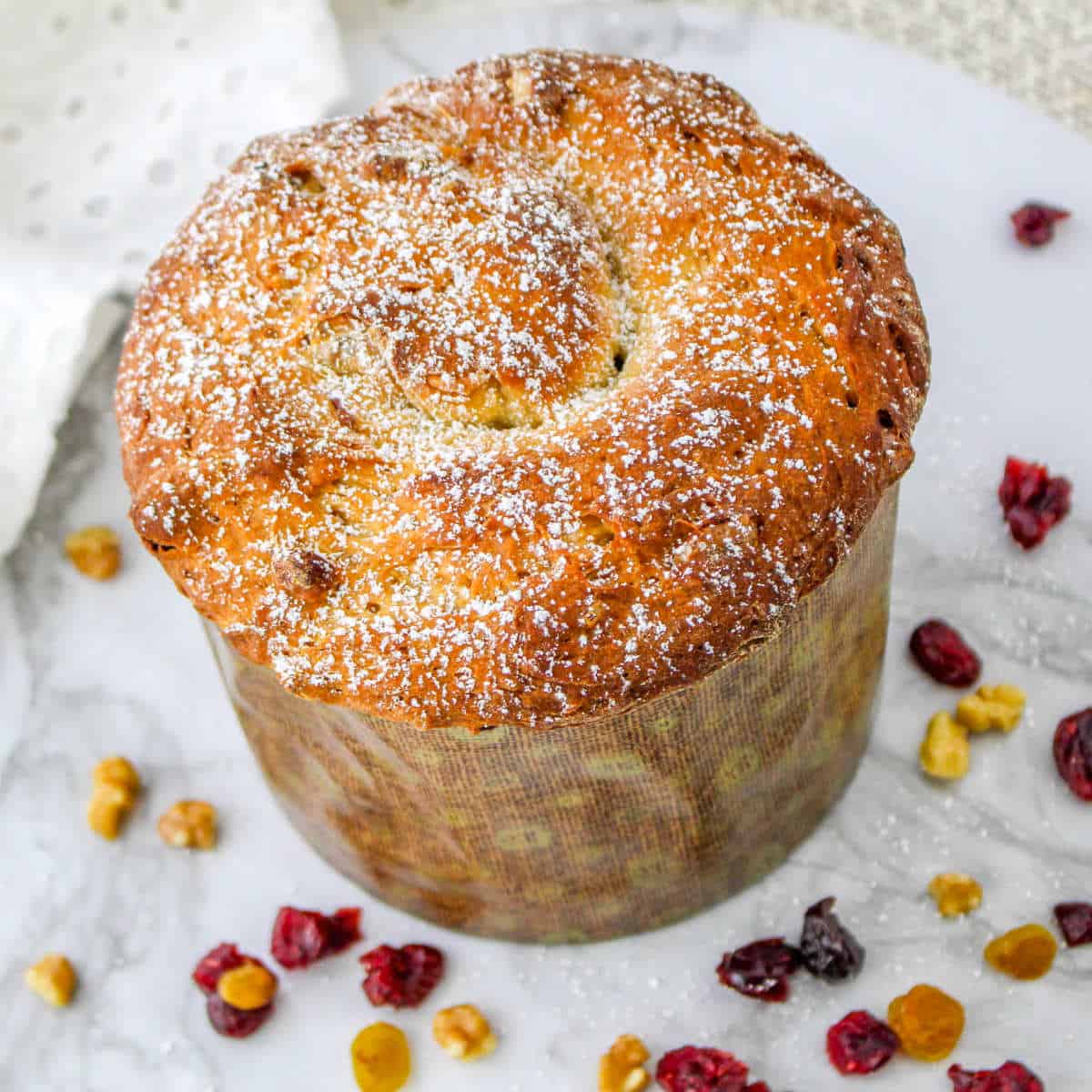
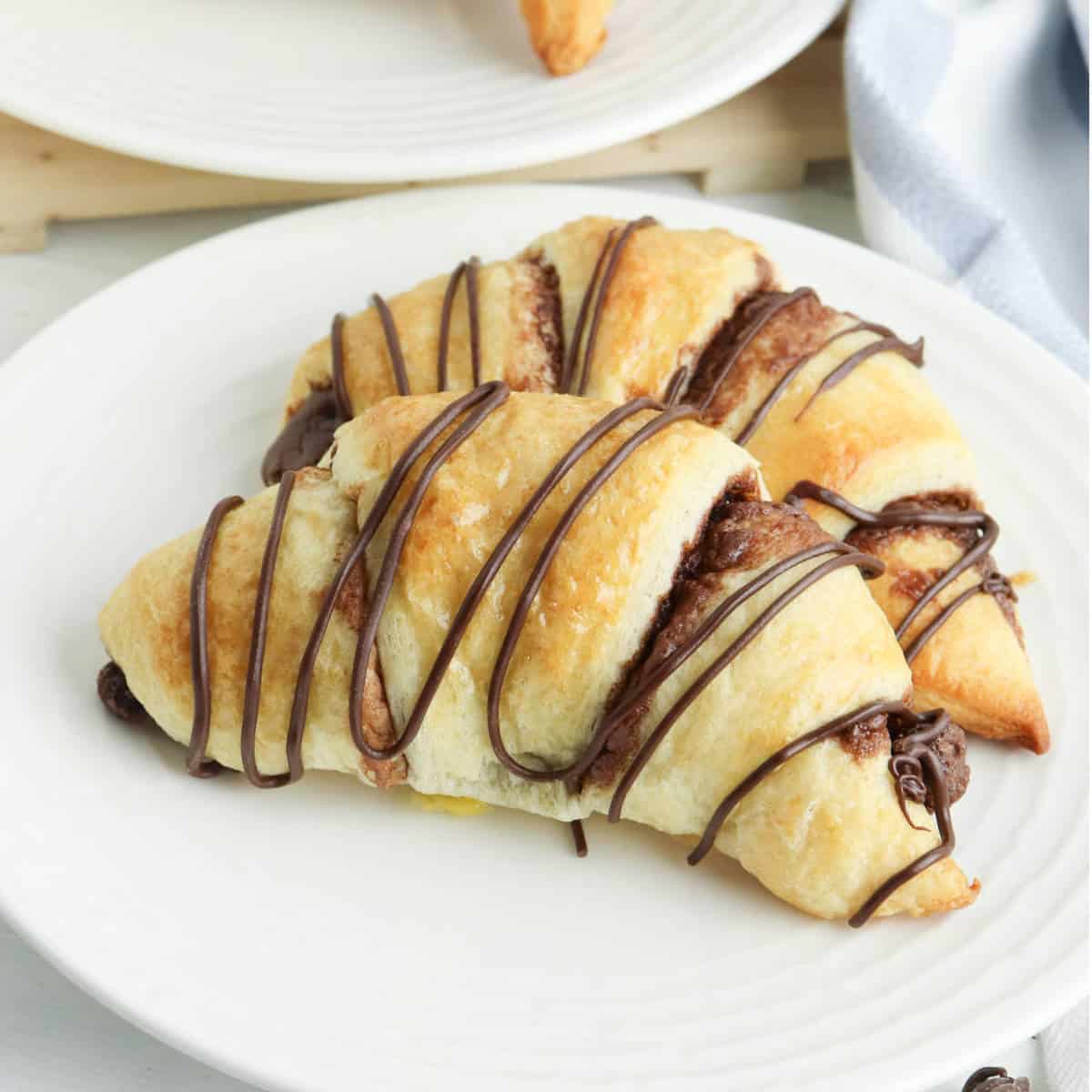
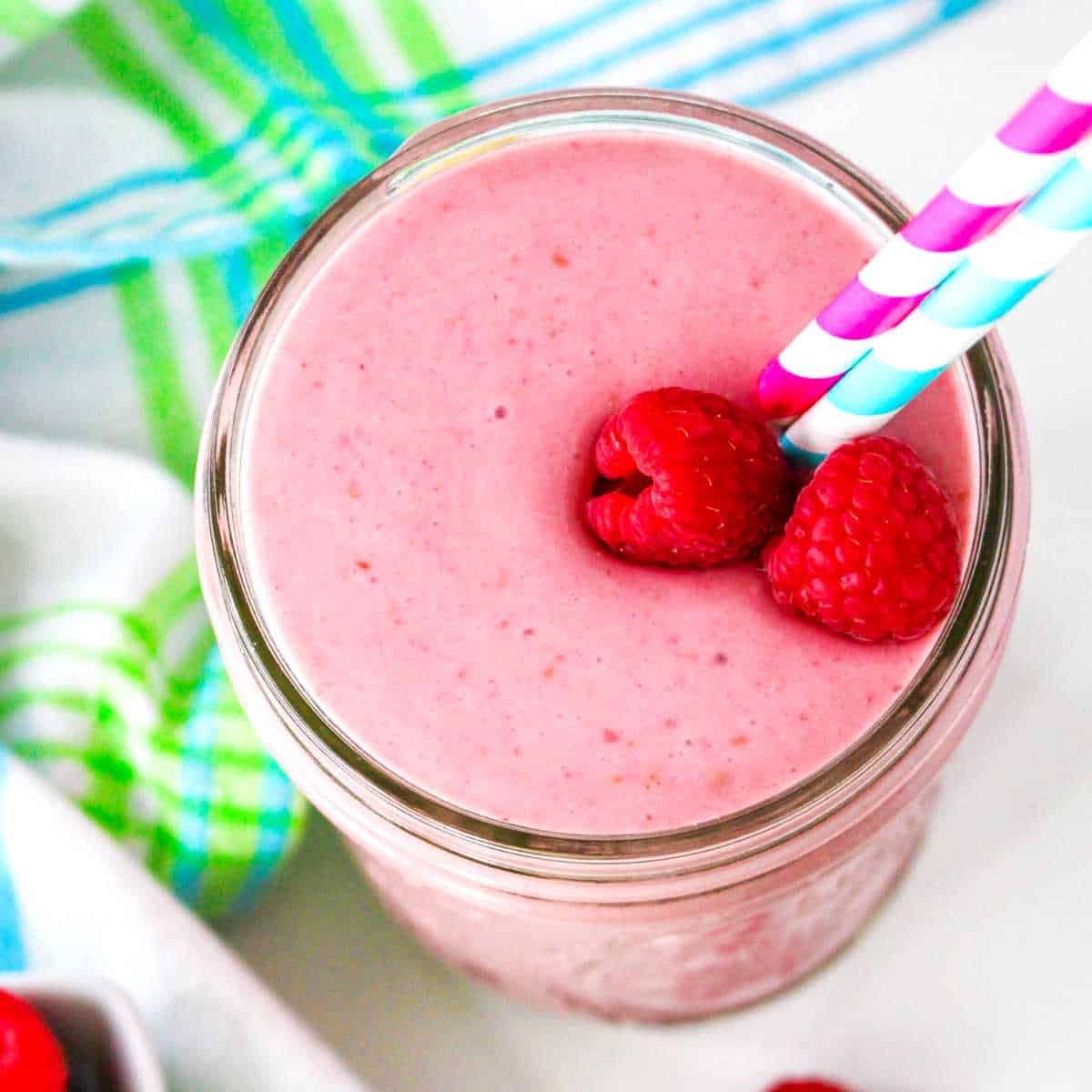
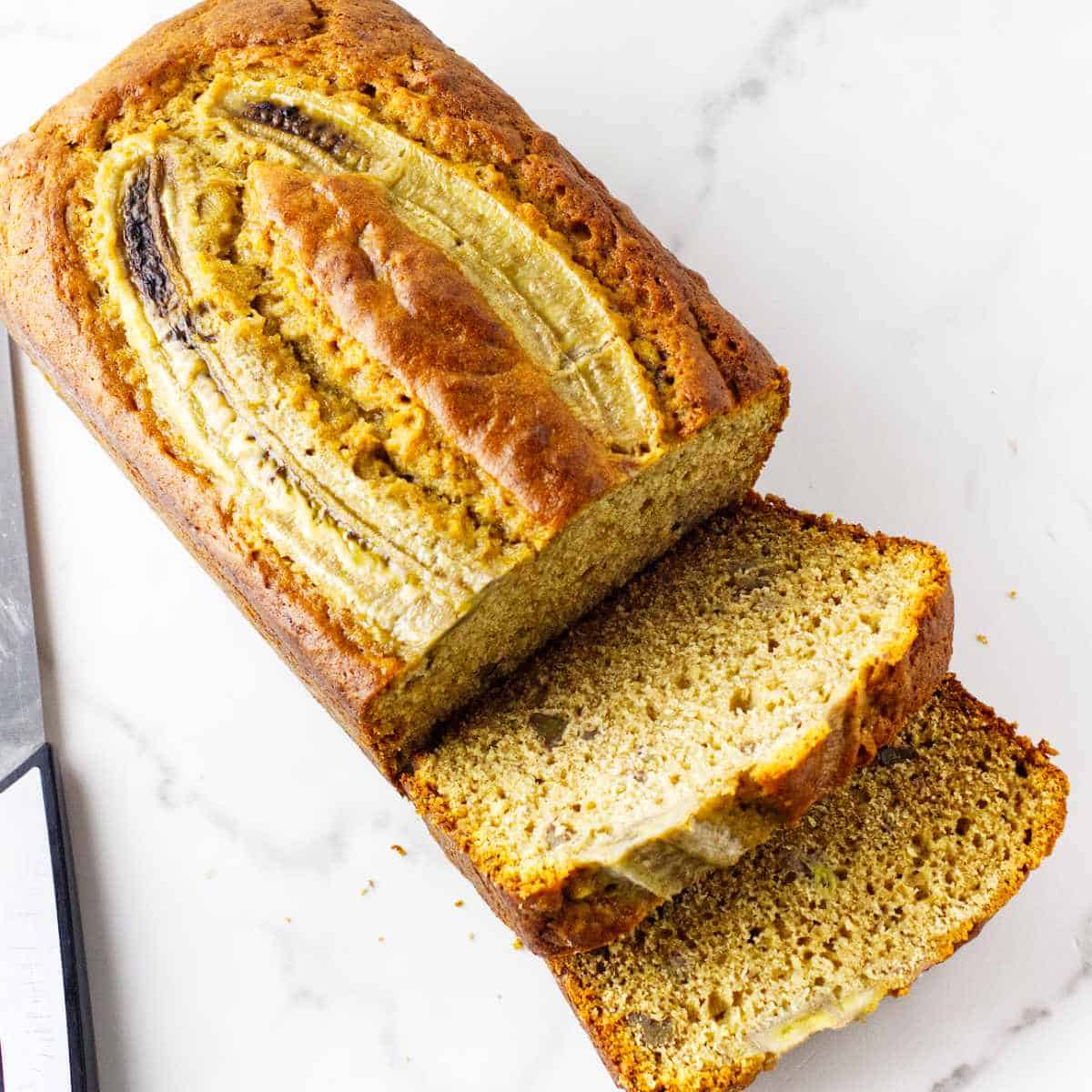
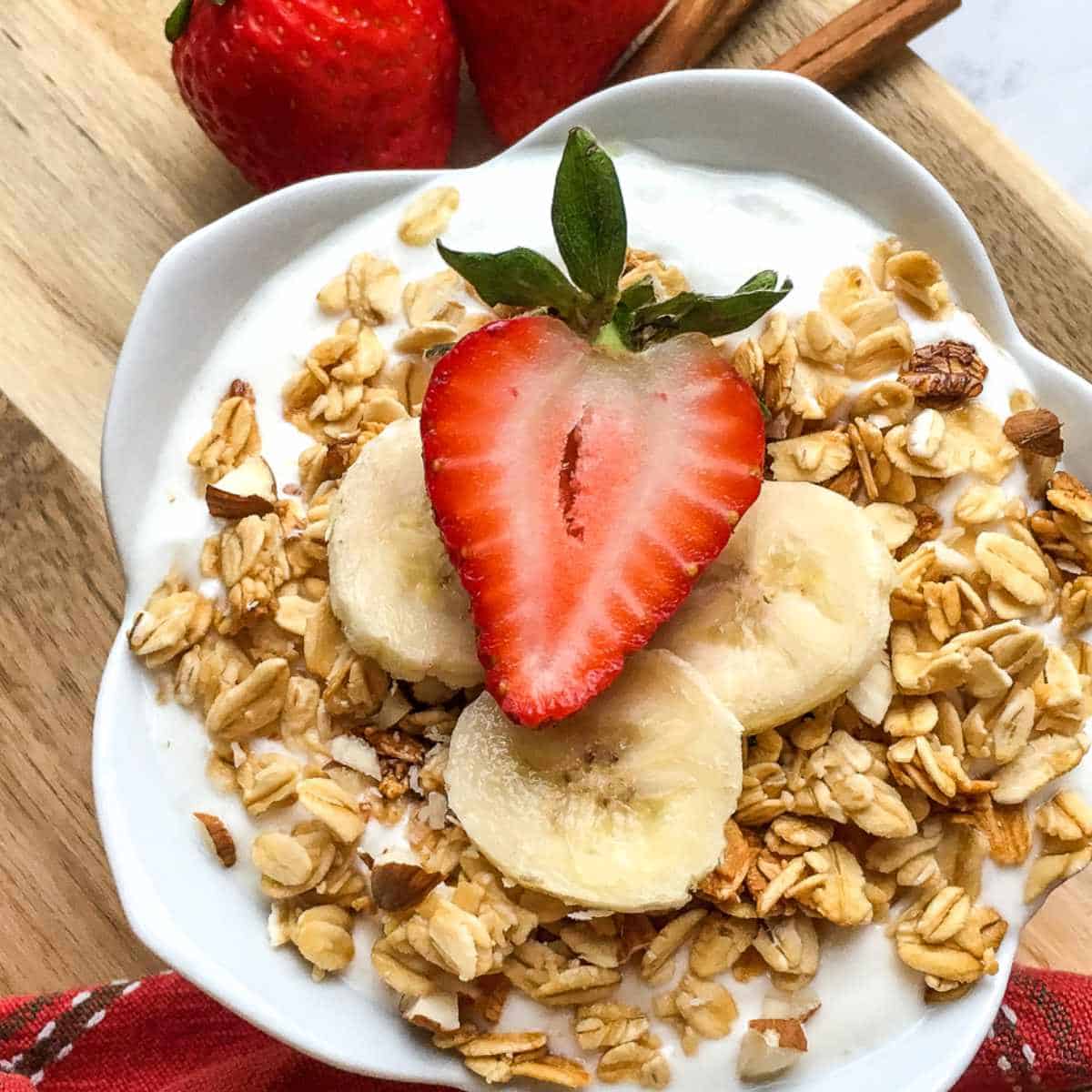
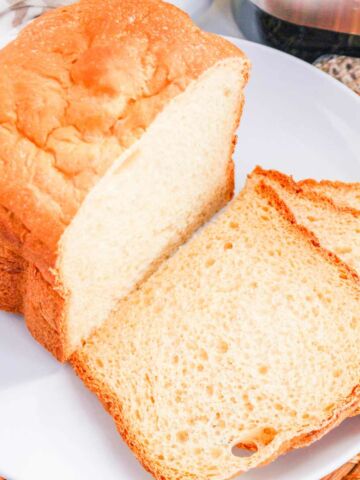


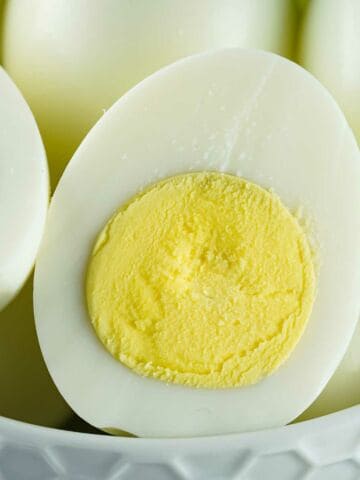
Maryann
If I want to use a smaller amount of milk, how do I determine what I need to do to adjust the measurements? I already have some Fairlife milk opened and it feels like a descent amount and I hate to buy a brand new carton as I am the only one that drinks it. And I do already have Faje lactose free Greek yogurt. I have a 6 qt Duo Crisp Imstant pot. I’m very anxious to make this yogurt in my instant pot.
Kelly Bloom
Maryann, Go down to the recipe card at the bottom of the post. There where it says "Servings 8" hover your mouse cursor over the number 8. You'll see a slide recipe resizer. If you want to make 2, 4, or 6 servings instead of 8, the recipe will automatically adjust the amounts to use. Hope that helps!
Mike
if I use regular yogurt as the starter but lactose free milk for the rest will it still end up being mostly lactose free?
Kelly Bloom
Yes, it will! The 2 - 3 tablespoons of regular yogurt to start with Lactose free is not enough cause issues. Be sure to save and freeze some of the lactose free yogurt you make though, you can use it to start the next batch without having to use regular yogurt for a starter!
Annie
The recipe says to use 3 Tbsp of yogurt on the recipe card, but 1/4 cup in other places. 1/4 cup is 4 Tbsp so which should I be adding?
Kelly Bloom
I updated the post to read 3 tablespoons to 1/4 cup. With brand new Fage yogurt, I can use the 3 tablespoons, but sometimes after several batches of homemade yogurt, I will use 1/4 cup, as the yogurt may be not quite as thick.
Michael
Straining the yoghurt with a cheesecloth/muslin is key to a thick Greek yogurt
Kelly Bloom
Believe it or not, this yogurt is already so thick that there is very little whey to strain off. You are right though, typically with regular milk you will need to strain to thicken. And as always, if you want it even thicker you can of course strain.
Anna
If the milk is ultra pasteurized, and it's only heated to 110⁰, does it need to cool further before mixing some with the starter yogurt? TIA!
I'm really excited to get to eat yogurt again!!! ?
Kelly Bloom
No, simply mix a little of the 110⁰ F milk with the starter live culture yogurt or dehydrated yogurt starter (I love the Bulgarian yogurt starter sold by Cultures for Life, it's not tart). Mix it so that it is smooth, then add it to the main 110 cooled milk. Stir, then pour into containers and process.
My dad has such a sensitive stomach to lactose, using the Ultra Pasteurized Lactose Free milk has been a game changer for him.